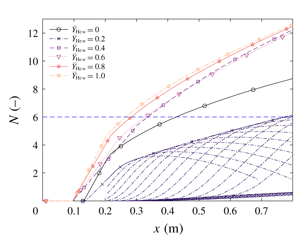Crossref Citations
This article has been cited by the following publications. This list is generated based on data provided by
Crossref.
Lukashevich, S. V.
Morozov, S. O.
and
Shiplyuk, A. N.
2021.
Experiments on the development of natural disturbances in a hypersonic boundary layer on surfaces with microgrooves.
Experiments in Fluids,
Vol. 62,
Issue. 7,
Miró Miró, Fernando
and
Pinna, Fabio
2021.
Decoupling ablation effects on boundary-layer stability and transition.
Journal of Fluid Mechanics,
Vol. 907,
Issue. ,
Guo, Peixu
Gao, Zhenxun
Jiang, Chongwen
and
Lee, Chun-Hian
2021.
Sensitivity analysis on supersonic-boundary-layer stability subject to perturbation of flow parameters.
Physics of Fluids,
Vol. 33,
Issue. 8,
Lysenko, V. I.
Gaponov, S. A.
Smorodsky, B. V.
Kosinov, A. D.
and
Yaroslavtsev, M. I.
2021.
Influence of surface sublimation on the stability of the supersonic boundary layer and the laminar–turbulent transition.
Physics of Fluids,
Vol. 33,
Issue. 2,
Liu, Xinyi
Luo, Zhenbing
Liu, Qiang
Cheng, Pan
and
Zhou, Yan
2023.
Numerical Investigation of Hypersonic Flat-Plate Boundary Layer Transition Subjected to Bi-Frequency Synthetic Jet.
Aerospace,
Vol. 10,
Issue. 9,
p.
766.
Li, Zongxian
Liu, Meikuan
Han, Guilai
Wang, Dagao
and
Jiang, Zonglin
2023.
Numerical simulation of hypersonic flat-plate boundary-layer blowing control.
Physics of Fluids,
Vol. 35,
Issue. 12,
Morozov, S. O.
Lukashevich, S. V.
and
Shiplyuk, A. N.
2023.
Numerical study of the influence of local foreign-gas injection on the linear stability of compressible boundary layer.
Thermophysics and Aeromechanics,
Vol. 30,
Issue. 2,
p.
209.
Hu, Yufa
Yi, Shihe
Liu, Xiaolin
Xu, Xiwang
and
Zhang, Bo
2024.
Experimental investigation on the effect of wall-seeping gas film on downstream second-mode waves in hypersonic boundary layer.
Aerospace Science and Technology,
Vol. 146,
Issue. ,
p.
108951.
Li, Zongxian
Liu, Meikuan
Han, Guilai
Wang, Dagao
and
Jiang, Zonglin
2024.
Experimental Study on Aerodynamic Heating of Hypersonic Boundary-Layer Blowing.
AIAA Journal,
Vol. 62,
Issue. 10,
p.
4011.
Hu, Yufa
Yi, Shihe
Liu, Xiaolin
and
Tian, Xudong
2024.
Effect of wall-seeping gas film on hypersonic laminar and transitional boundary layers.
Physics of Fluids,
Vol. 36,
Issue. 12,
Kerth, Philipp
Le Page, Laurent M.
Wylie, Sebastien
Ravichandran, Raghul
Ceruzzi, Andrew
Williams, Benjamin A. O.
and
McGilvray, Matthew
2024.
Displacement of hypersonic boundary layer instability and turbulence through transpiration cooling.
Physics of Fluids,
Vol. 36,
Issue. 3,
Zhang, Xiaobing
and
Wang, Zekang
2025.
Thermal protection and drag reduction induced by flow control devices in supersonic/hypersonic flows: A review.
Progress in Aerospace Sciences,
p.
101093.
Chinske, Christopher C.
and
Jewell, Joseph S.
2025.
Boundary-Layer Instabilities on Variable Bluntness Cones with Outgassing in Hypersonic Quiet Flow.
AIAA Journal,
p.
1.
Russo, Vincenzo
Saikia, Bijaylakshmi
and
Brehm, Christoph
2025.
Effects of Injection Gas Temperature on Stability of High-Enthalpy Boundary Layer Flows With Transpiration Cooling.

 $^{N}$ method, to establish the underlying reason for the experimentally observed advancement/delay of transition in sharp slender hypersonic cones, when injecting lighter/heavier gases. Contrary to the current understanding and experimental correlations, this numerical analysis suggests that such a behaviour is not linked to the isolated effect of the injected gas’ molar weight, but to its combination with the blowing discontinuity, porosity and the appearance of a shocklet, consequence of the injected gas composition. The shocklet constitutes a density gradient that acts on second-mode instabilities like a thermoacoustic impedance.
$^{N}$ method, to establish the underlying reason for the experimentally observed advancement/delay of transition in sharp slender hypersonic cones, when injecting lighter/heavier gases. Contrary to the current understanding and experimental correlations, this numerical analysis suggests that such a behaviour is not linked to the isolated effect of the injected gas’ molar weight, but to its combination with the blowing discontinuity, porosity and the appearance of a shocklet, consequence of the injected gas composition. The shocklet constitutes a density gradient that acts on second-mode instabilities like a thermoacoustic impedance.